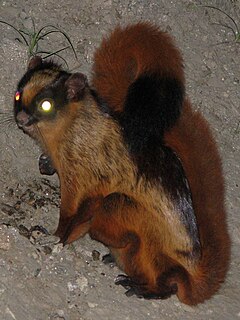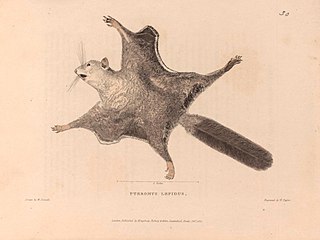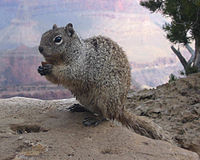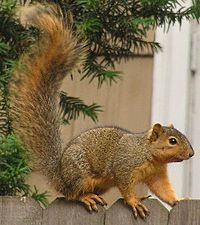
Squirrels are members of the family Sciuridae, a family that includes small or medium-size rodents. The squirrel family includes tree squirrels, ground squirrels, and flying squirrels. Squirrels are indigenous to the Americas, Eurasia, and Africa, and were introduced by humans to Australia. The earliest known fossilized squirrels date from the Eocene epoch, and among other living rodent families, the squirrels are most closely related to the mountain beaver and to the dormice.

Flying squirrels are a tribe of 50 species of squirrels in the family Sciuridae. Despite their name, they are not in fact capable of full flight in the same way as birds or bats, but they are able to glide from one tree to another with the aid of a patagium, a furred parachute-like skin membrane that stretches from wrist to ankle. Their long tails also provide stability as they glide. Anatomically they are very similar to other squirrels with a number of adaptations to suit their lifestyle; their limb bones are longer and their hand bones, foot bones, and distal vertebrae are shorter. Flying squirrels are able to steer and exert control over their glide path with their limbs and tail.

Sciurinae is a subfamily of squirrels, uniting the flying squirrels with certain related tree squirrels. Older sources place the flying squirrels in a separate subfamily (Pteromyinae) and unite all remaining sciurids into the subfamily Sciurinae, but this has been strongly refuted by genetic studies.

The Namdapha flying squirrel is an arboreal, nocturnal flying squirrel endemic to Arunachal Pradesh in northeast India, where it is known from a single specimen collected in Namdapha National Park in 1981. No population estimate is available for B. biswasi, but the known habitat is tall Mesua ferrea jungles, often on hill slopes in the catchment area of Dihing River in northeastern India.

The red giant flying squirrel or common giant flying squirrel is a species of rodent in the family Sciuridae (squirrels). It is found in a wide variety of forest–types, plantations and more open habitats with scattered trees in Southeast Asia, ranging north to the Himalayas and southern and central China. One of the largest arboreal squirrels, all populations have at least some reddish-brown above and pale underparts, but otherwise there are significant geographic variations in the colours. The taxonomic position of those in the Sundaic region is generally agreed upon, but there is considerable uncertainty about the others, which variously have been included in this or other species, or recognized as their own species.

The groove-toothed flying squirrel or North Chinese flying squirrel is a species of rodent in the family Sciuridae. It is monotypic within the genus Aeretes. It is endemic to China, and occurs in Sichuan, Gansu, Hebei, and Beijing. Its natural habitat is temperate forests.

The black flying squirrel or large black flying squirrel is a species of rodent in the family Sciuridae. It is found in Brunei, Indonesia, and Malaysia; its habitat is primary and secondary forests and gardens where it uses tree hollows. It feeds on fruits, nuts and other vegetable matter. It is likely not threatened and is adaptable to habitat loss. Black flying squirrels tend to have smaller populations than other squirrels because female black flying squirrels breed infrequently and have a small litter size of just one young.
Thomas's flying squirrel is a species of rodent in the family Sciuridae. It is one of two species in the genus Aeromys. It is found in Indonesia and Malaysia.
The Kashmir flying squirrel is a species of rodent in the family Sciuridae. It is monotypic within the genus Eoglaucomys. It is found in Afghanistan, India and Pakistan. Its natural habitat is subtropical or tropical dry forests. It is threatened by habitat loss. The Afghan flying squirrel is usually considered a subspecies.

Epixerus ebii, also known as Ebian's palm squirrel, Temminck's giant squirrel, or the western palm squirrel, is a species of rodent in the family Sciuridae. It is the only species in the genus Epixerus, although eastern populations were previously regarded as a separate species, E. wilsoni. It is found in West and Central Africa. Its natural habitat is subtropical or tropical moist lowland forests. It is threatened by habitat loss.

The jungle palm squirrel, jungle striped squirrel, or Western Ghats squirrel is a species of rodent in the family Sciuridae endemic to India. Its natural habitats are subtropical or tropical dry forests, but it is tolerant to habitat changes and is also common in tea plantations in the Western Ghats. It is confined to forests with tall trees along the west coast of the Indian Peninsula. This confinement has led the jungle palm squirrel to be considered a pest on cacao, mangos, grapes, and sapota, plants that commonly grow in the type of forest. The ratio between males and females is not split evenly; males have been reported to have a larger population share. Potential factors for the uneven sex ratio include differences in "rate of persistence, mortality, dispersal, and predation pressure".

The spotted giant flying squirrel, also known as the lesser giant flying squirrel, is a species of rodent in the family Sciuridae. It is found in hill and mountain forests at altitudes of 200–4,000 m (660–13,120 ft) in Southeast Asia north to central China and the east Himalayan region, although the northern populations sometimes are regarded as separate species as the grey-headed giant flying squirrel, Chindwin giant flying squirrel and P. marica. Two of these, as well as a few other populations, lack the white spots on the upperparts for which it is named. Although a large flying squirrel, it is a relatively small giant flying squirrel.

The Bhutan giant flying squirrel, also known as the Gray's giant flying squirrel or noble giant flying squirrel, is a species of rodent in the family Sciuridae. This species lives in Himalayan forests and it is one of the largest flying squirrels. Like other flying squirrels, it is mainly nocturnal and able to glide long distances between trees by spreading out its patagium, skin between its limbs.

The Basilan flying squirrel is a species of rodent in the family Sciuridae. It is endemic to the Philippines. It is often confused with mindanao flying squirrel

The whiskered flying squirrel is a species of flying squirrel. It is found in Indonesia and Malaysia.
Hagen's flying squirrel is a species of rodent in the family Sciuridae. It is endemic to Indonesia.
The Siberut flying squirrel is a species of rodent in the family Sciuridae. It is endemic to Indonesia. Its natural habitat is subtropical or tropical dry forests. It is threatened by habitat loss.

The arrow flying squirrel is a species of flying squirrel. It is endemic to Java and Bangka, Indonesia. The population is unknown as it has only been collected from a few localities. It is nocturnal and arboreal and may be found in primary and secondary forest. It is threatened by forest loss due to logging and agriculture and there are no known conservation actions.

Temminck's flying squirrel is a species of rodent in the family Sciuridae. It is found in Indonesia, Malaysia, Myanmar, and Thailand.
Kloss's squirrel or Kloss squirrel is a species of rodent in the family Sciuridae. It is endemic to northern Sumatra in Indonesia. Population data is insufficient to assess its conservation status according to the IUCN. It is sometimes considered a subspecies of C. notatus.

















